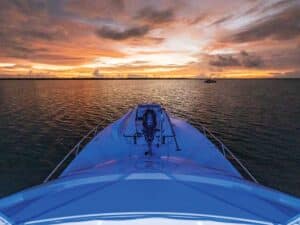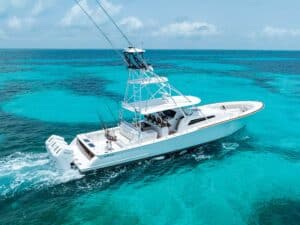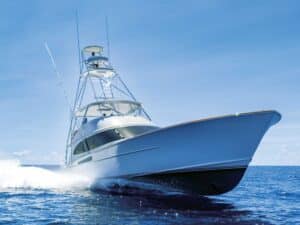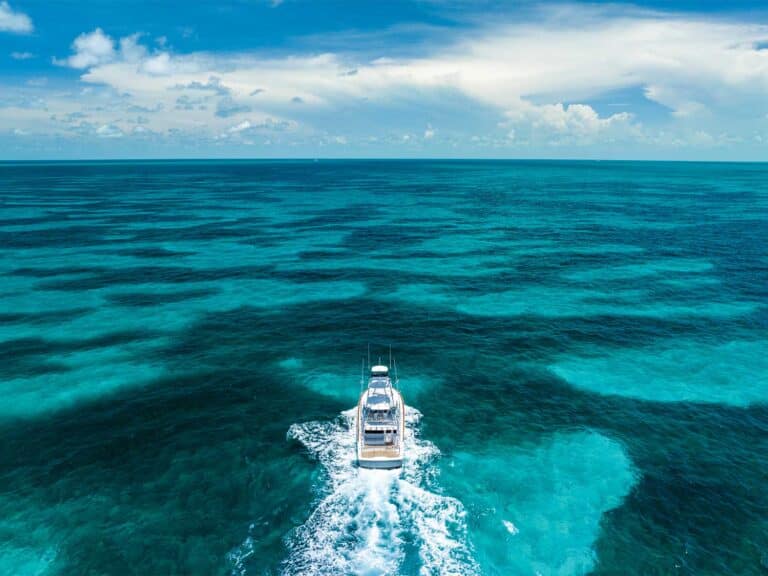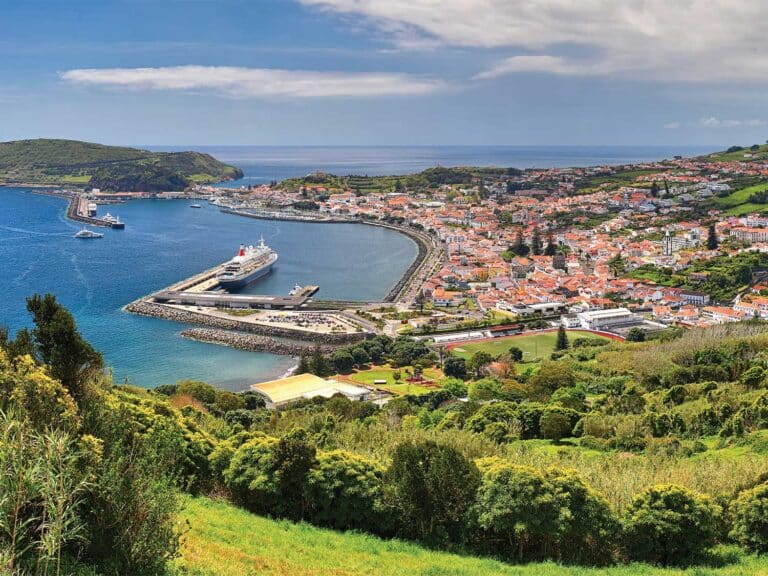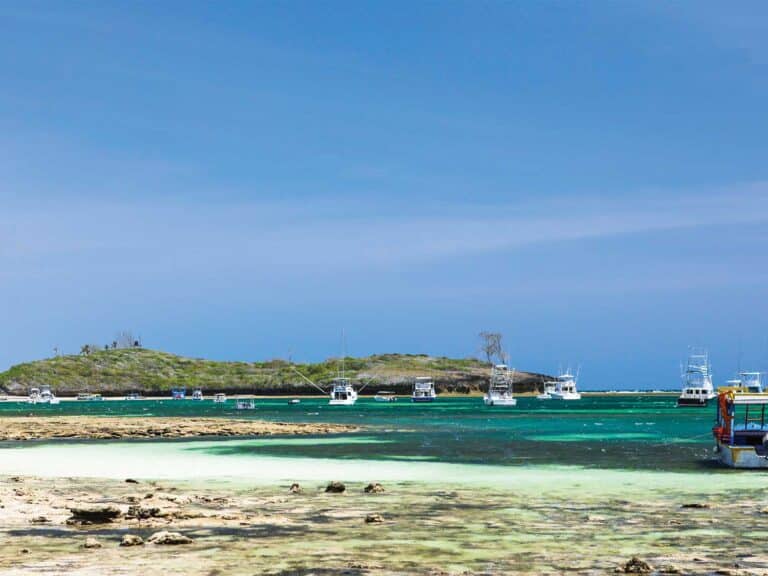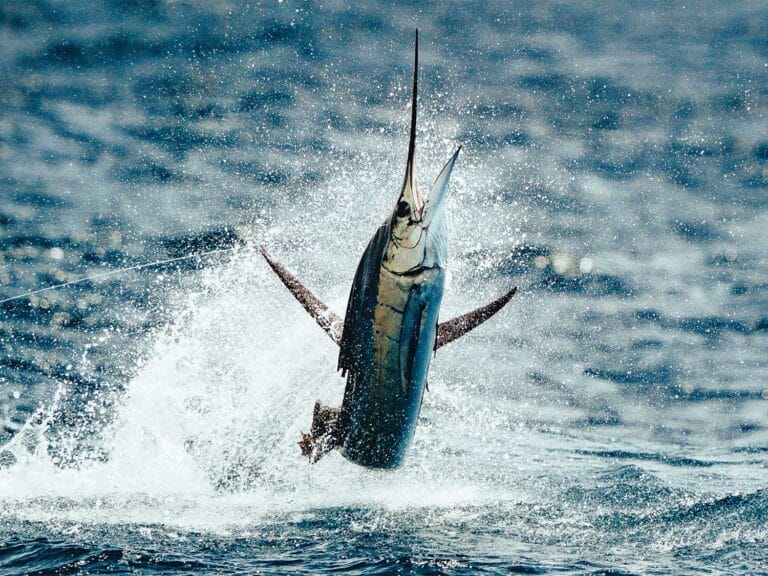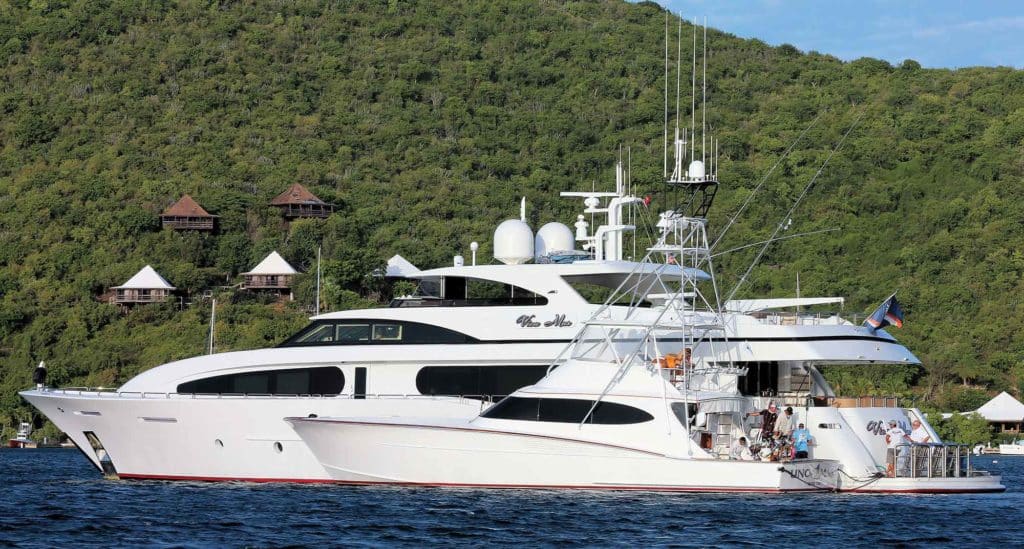
The concept of using a mothership for accommodations and long-distance travel while fishing from smaller game boats that are towed behind, hauled aboard or run in tandem is nothing new. Close to 100 years ago, Zane Grey — the first angler with a documented 1,000-pound blue marlin catch — explored the possibilities with a 190-foot three-masted schooner that was converted to diesel power and carried several small fishing boats aboard. Decades later, mothership operations such as The Madam and The Hooker (with 80 world records to its credit) and the El Zorro/El Zorro II team (a 100-foot mothership that carried a 32-foot crane-launched Sunny Briggs) would travel the world and go on to pioneer mothership/sport-fishing-boat operations. And today, the use of a mothership has become almost commonplace.
Almost.
Despite the popularity of the arrangement, the one obvious drawback is the expense associated with running both a yacht and a sport-fishing boat. This naturally limits the pool of potential, and that’s not the only downside to running a mothership operation. But the advantages of such a scenario are, in many ways, unbeatable.

Team-Building Exercise
As we spoke with owners and captains of mothership/game-boat ventures, the big issue that popped up again and again was assembling the right crews. Yes, crews: In most cases, a mothership operation requires separate personnel to run each boat. But it’s imperative that the two teams are able to work well together seamlessly.
“The owner has the ultimate challenge to make sure everyone meshes,” says Randy Ringhaver, owner of Carson, a 148-foot Newcastle motoryacht that travels with his 86-foot Merritt, Bree. “Big egos or authoritarian attitudes don’t make for a happy operation. I have not experienced such a situation, as I follow Jim Collins’ advice in his book Good to Great: Make sure you have the right people on the bus!”
He then thoughtfully adds, “My wife and I jointly interview all crewmembers because I feel that a woman’s intuition is better than a glossy resume.”
Bree Capt. Kyle Liane echoes Ringhaver’s sentiments, mentioning that a large crew can be an asset, as well as a challenge. “Large crews can certainly lead to personality conflicts,” he says. “But fortunately, that’s not a problem in our case. In fact, having the yacht crew takes a tremendous amount of pressure off the fishing-boat crew. That’s probably the best thing about having the mothership around. When we get up early, fish all day and arrive back late, the yacht crew more or less takes over for the remainder of the evening. We’re all working toward the same goal, which is keeping the owner and guests happy, so it’s a big relief. It lets us catch our breath. In fact, if anything, it improves our ability to fish. We have time to get everything ready for the next day and get a good night’s sleep.”
Capt. Jason Buck, who runs the 70-foot Viking Done Deal for owner Jon Gonsoulin, in tandem with the 110-foot Enterprise, identifies the exact same aspect of the mothership/fishing-boat relationship as a key advantage from a fishing perspective. Recognizing that Enterprise is a very unusual mothership — a massive cat-hulled houseboat with a helipad on the top deck — that’s used for support and travel as Done Deal tournament-fishes along the Gulf Coast, a dual crew is again a necessity. But Buck is also quick to point out that it allows the anglers to stay focused on the fishing. “We share a lot of responsibilities,” Buck says. “But having Enterprise there means we don’t have to worry about things like cooking dinner, or entertaining guests when our boss wants to have a big party. We can stay focused on the tournament prep.”
It’s worth pointing out that Done Deal won the Blue Marlin World Cup this year with a 600-pound blue marlin, fishing out of Orange Beach, Alabama. Aside from tournament fishing, however, working with a mothership like Enterprise does also have some drawbacks.
“Enterprise is not the best for runs through big water,” notes Buck. “And it can barely handle sizable waves. So I’d hesitate to even call it a ‘mothership’ operation, like one of the big boats that can travel around the world. Getting it to and from different places has its issues. But in some ways, that makes it even better — it’s sort of a redneck dream, to tell you the truth, and it’s used for hunting parties as much as for fishing. The best part of winning the World Cup was that we were barely 30 miles from the boss’s duck blind.”
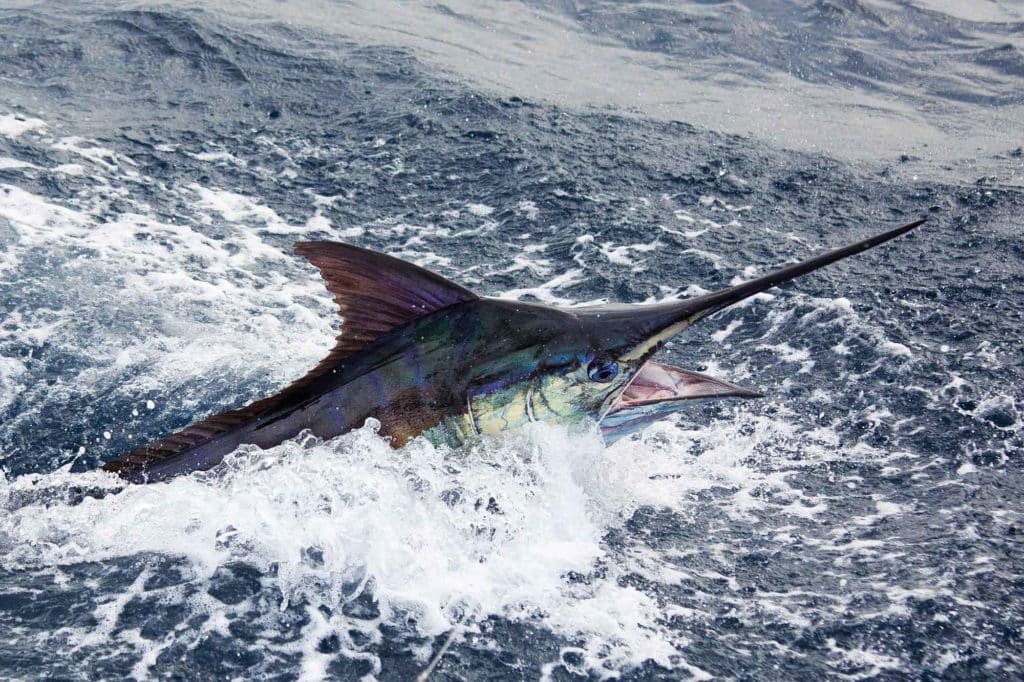
The Big Haul
For those operations that do engage in major travel, the upsides and downsides to consider are numerous. Logistics can always be an issue, and many other potential problems may arise depending on how the boats travel: each on its own bottom; with the fishing boat loaded on the mothership; or with the fishing boat under tow.
“There’s virtually nowhere we can’t go,” says Capt. Michael Sedrick, who runs the 92-foot Paragon Endless Summer with the 34-foot Regulator North Star towed behind it. “We go to the Bahamas, and we go up north and fish in the bluefin tournaments, and while fishing with the Regulator isn’t like fishing from a big boat, it actually gives us a lot more flexibility. But it’s not problem free.”
The problematic part of this equation is the towing. “It can be very challenging,” Sedrick notes. “There are some bridges on the Intracoastal Waterway you can’t tow through. The tow can wander at slow speeds. Weather is always an issue, and can make it difficult to unhook the tow. On a recent trip to the Abacos, it was blowing hard when we arrived, and it was a very challenging situation. On top of that, you have to be very diligent. Every bit of gear has to be checked before and after every trip. The tow line has to be rinsed and covered. You have to carry spares for everything, and you have to consider the legalities and get approval from the insurance company. There’s a lot to plan for.”
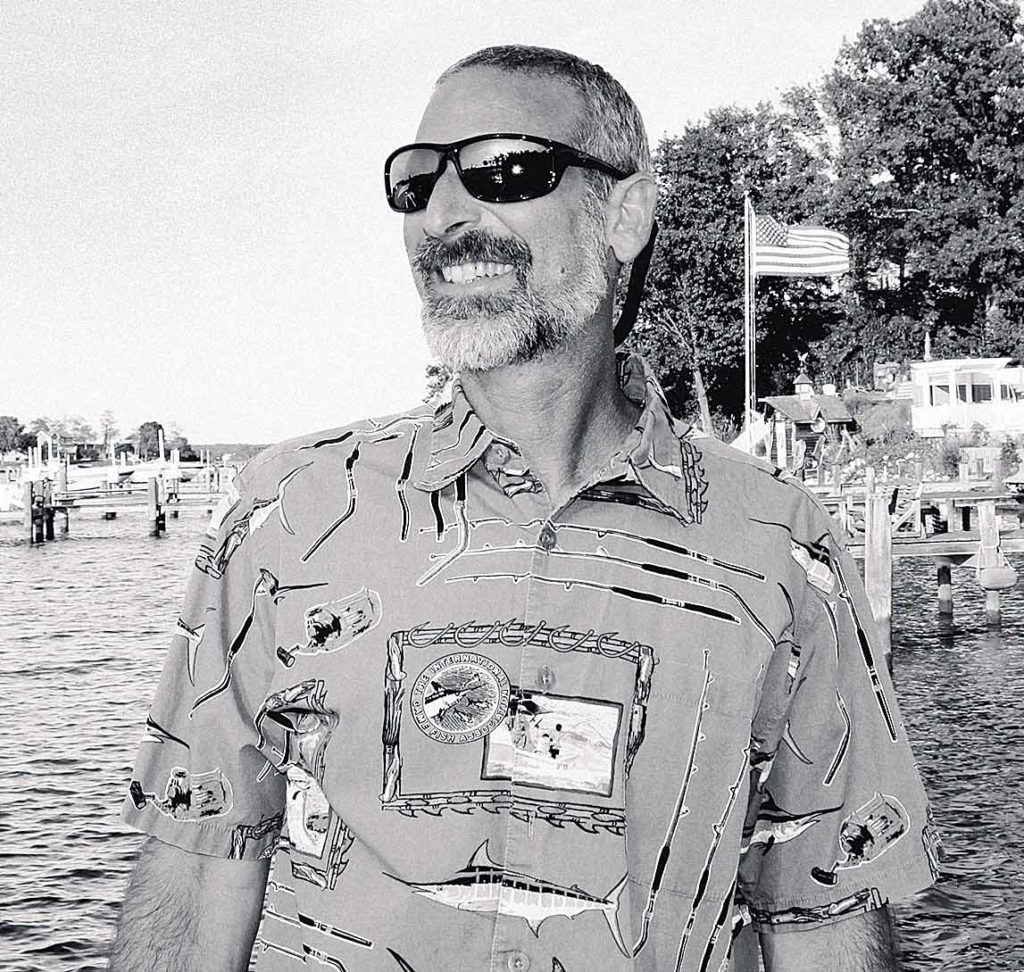
But when asked about whether the extra hassle is worthwhile, both Sedrick and owner Thomas Moloney don’t hesitate to answer in the affirmative. “Once we set up shop with the big boat, we can do just about anything in the Regulator,” Moloney explains. “We can make long runs quickly when we’re fishing, its shallow draft means we can go exploring around and we can take it places where the big boat wouldn’t have the space to tie up.”
Just as important, pairing a center console with the motoryacht works better from a family perspective. When asked why he chose to take the mothership route instead of purchasing a single large sport-fishing boat Moloney laughs, then says, “I like my marriage! My wife loves the Paragon. She likes the Regulator too, plus the grandkids love staying on the big boat and being able to run around in the center console.”
“Tom and the entire Moloney clan are really into it,” Sedrick adds. “Winter, summer, you name it. We’ve gone on trips where we’ve fished for 13 out of 15 days, and everyone has had a great time. You just can’t do that with an entire family on a big sport-fisher and keep everyone happy at the same time.”
Moloney’s experience is anything but unique. In fact, according to Regulator’s director of sales and marketing, Keith Ammons, the more versatile nature of a smaller boat is a main reason customers cite when going the mothership/sport-fisher/center console route.
“The ability to get into shallow water, and the ability to cover more ground, is important,” Ammons says. “The story I’ve heard a few times is of taking the big boat to a remote island, anchoring up, and calling it home. Then, the ‘dinghy,’ the center console, is used to fish with the kids or go on day trips all over the area.” When accompanied by a larger sport-fisher, the versatility (and fun) is multiplied even further.
Ammons says the company’s 34-footer is one of the most popular models to tow behind a larger sport-fisher or mothership. “Regulators are good boats for this purpose because they’re top-quality,” he notes. “And they match the high expectations that these owners expect in all of their vessels. They have great fishability and can be used to target a bunch of different species too.”
The logistical issues faced by crews running boats that can’t be towed, naturally, present a very different set of challenges. Bree‘s Liane, for example, has to worry about timing and speed when the two boats travel. “The big boat cruises at 12 knots, and we cruise at 30,” he explains. “We usually want to be at the same place at the same time, so it does take a bit of planning, but in truth it’s pretty easy.”
Buck has the same issue, noting that the houseboat with which he runs in tandem cruises at a whopping 7 knots. “There are all sorts of gives and takes, and it can be a pain in the butt coordinating with the other boat,” he says. “Sometimes it means doing what’s not necessarily the best thing for fishing. But it’s also lots of fun and makes for great camaraderie, and life is short, so we’d better enjoy this while we can. If it means we’re a day later or we stay inland instead of running outside, so be it.”
Read Next: Global Fishing Exploration: Motherships
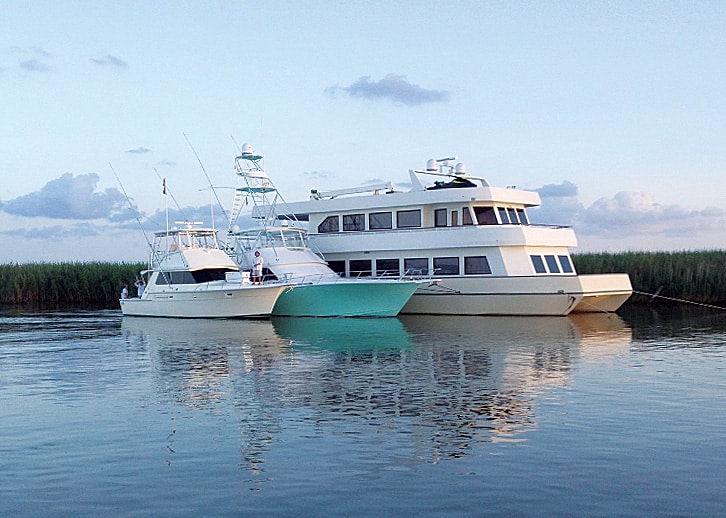
The Big Mother
Along with all of these factors, there are a number of small but important advantages that go along with fishing à la mothership. Virtually everyone we spoke with mentioned how much they appreciate the ability to carry numerous spare parts, for everything from mechanicals to additional fishing gear. Having essentially unlimited freezer space is another big bonus. It’s also nice to be able to offer guests the option to stay behind and spend the day on the mothership if they aren’t hardcore enough for the weather conditions offshore. Being able to hook up to the mothership for power and give the onboard generators a break was also mentioned as a plus. But overall, range and flexibility are the defining factors.
“You can pretty much fish anywhere and anytime you want,” says Ringhaver. “There’s no need for dockage reservations and that type of long-term planning. And you can switch directions if the fishing is slow.”
Liane agrees, adding that even the type of fishing they can do expands with the mothership at hand. “We can go offshore fishing, we can go inshore fishing or we can even go flats fishing on the skiff (which lives atop Carson’s upper deck). All of these options diversify the fishing experience and give us a ton of flexibility. Without the mothership operation, this just wouldn’t be possible.” And having those options also opens up the possibilities for larger groups as well; guests can rotate through a day of chasing blue marlin and tuna offshore, then fishing inshore or diving the next, plus using the outboard to visit nearby islands for sightseeing, all while enjoying the luxury and amenities available back aboard the mothership at the end of the day.
The bottom line? Each of the owners and captains we spoke with felt that running a mothership operation as opposed to a single boat gave them vastly greater versatility and adaptability, both for fishing and other aspects of boating, including the all-important social side of things. All felt that the flexibility far outweighed any negative aspects of a multivessel operation. And each believed that the mothership/game boat/center console combination is simply an unbeatable option for that next big offshore adventure.

